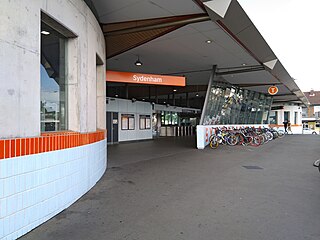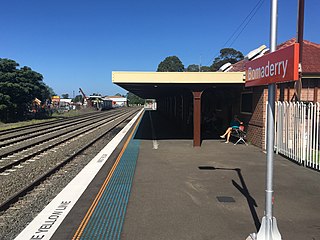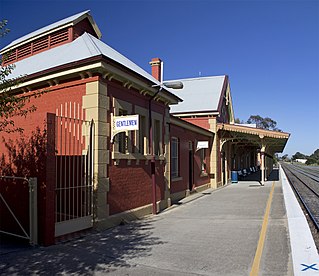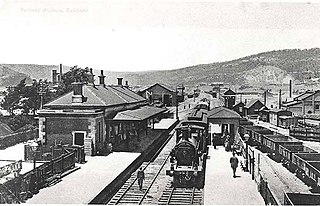
Sydenham railway station is a heritage-listed railway station located on the Illawarra line, serving the Sydney suburb of Sydenham in New South Wales, Australia. It is served by Sydney Trains T3 Bankstown, T4 Illawarra and T8 South services. It was designed by the New South Wales Government Railways and built from 1884 to 1962, with William Robinson having built the original 1884 buildings. It was added to the New South Wales State Heritage Register on 2 April 1999.

Riverstone railway station is a heritage-listed railway station at Riverstone Parade, Riverstone, City of Blacktown, New South Wales, Australia. It was designed by NSW Government Railways and William Weaver and built from 1883 to 1939. The station is located on the Richmond line, and is served by Sydney Trains T1 Western and T5 Cumberland line services. The property was added to the New South Wales State Heritage Register on 2 April 1999.

Windsor railway station is a heritage-listed railway station located on the Richmond line, serving the Sydney suburb of Windsor, in New South Wales, Australia. It is served by Sydney Trains T1 Western and T5 Cumberland line services. It was added to the New South Wales State Heritage Register on 2 April 1999.

Rockdale railway station is a heritage-listed railway station located on the Illawarra line, serving the Sydney suburb of Rockdale in Bayside Council. It is served by Sydney Trains T4 line services. It was added to the New South Wales State Heritage Register on 2 April 1999.

Canterbury railway station is a heritage-listed railway station located on the Bankstown line at Canterbury in the City of Canterbury-Bankstown local government area of New South Wales, Australia. The station is served by Sydney Trains T3 Bankstown line services. The station was designed by New South Wales Government Railways and built from 1895 to 1915 by J. J. Scouller. It is also known as Canterbury Railway Station group. The property was added to the New South Wales State Heritage Register on 2 April 1999.

Leeton railway station is a heritage-listed former goods yard and railway station and now bus station and railway station located on the Yanco–Griffith line at Dunn Avenue in Leeton in the Leeton Shire local government area of New South Wales, Australia. It is also known as Leeton Railway Station and yard group. The property was added to the New South Wales State Heritage Register on 2 April 1999.

Berry railway station is a heritage-listed single-platform intercity train station located in Berry, New South Wales, Australia, on the South Coast railway line. The station serves NSW TrainLink diesel multiple unit trains travelling south to Bomaderry and north to Kiama. Early morning and late night services to the station are provided by train replacement bus services. In the past, the station precinct also catered to freight trains carrying cattle and dairy products.

Bomaderry railway station is a heritage-listed single-platform intercity train station located in Bomaderry, New South Wales, Australia, on the South Coast railway line. The station serves NSW TrainLink diesel multiple unit trains to Kiama. Early morning and late night services to the station are provided by train replacement bus services. A siding near the station is used by freight trains operated by the Manildra Group.

St Marys railway station is a heritage-listed former goods yard, railway signal box and now railway station located on the Main Western line in the western Sydney suburb of St Marys in the City of Penrith local government area of New South Wales, Australia. The station is served by Sydney Trains T1 Western line services. The station marks the end of the four-track section of the Main Western line. It was designed by New South Wales Government Railways and was built in 1862. It is also known as St. Marys Railway Station Group and St Marys Railway Station. The property was added to the New South Wales State Heritage Register on 2 April 1999.

Tahmoor railway station is a heritage-listed railway station located on the Main South line in the town of Tahmoor, part of the Wollondilly Shire local government area of New South Wales, Australia. The property was added to the New South Wales State Heritage Register on 2 April 1999 where it is also known as the Tahmoor Railway Station Group and Lupton's Inn. The station opened on 13 July 1919 at the same time as a new alignment between Picton and Mittagong railway stations.

Lawson railway station is a heritage-listed railway station located on the Main Western line in Lawson in the City of Blue Mountains local government area of New South Wales, Australia. It is also known as Lawson Railway Station Group and Christmas Swamp; Blue Mountain. The property was added to the New South Wales State Heritage Register on 2 April 1999. The station opened on 11 July 1867 as Blue Mountain, being renamed Lawson on 21 April 1879. A passing loop exists north of Platform 1. As part of widening work to the Great Western Highway, a siding south of Platform 2 was removed and a new submerged siding constructed west of the station.

Katoomba railway station is a heritage-listed railway station located on the Main Western line in Katoomba, New South Wales, Australia. It serves the Blue Mountains town of Katoomba opening on 2 February 1874 as Crushers, being renamed Katoomba on 9 July 1877.

Queanbeyan railway station is a heritage-listed railway station located on the Bombala line in New South Wales, Australia. It serves the town of Queanbeyan.

Orange railway station is a heritage-listed former railway bridge and now railway station located on the Main Western line on Peisley Street, Orange in the City of Orange local government area of New South Wales, Australia. It was built from 1877 to 1950. It is also known as Orange Railway Station and yard group. The property was added to the New South Wales State Heritage Register on 2 April 1999.

Parkes railway station is a heritage-listed former locomotive depot and railway station and now locomotive roundhouse and railway station located on the Broken Hill line in May Street, Parkes in the Parkes Shire local government area of New South Wales, Australia. The railway station serves the town of Parkes and was built from 1881 to 1893. It is also known as the Parkes Railway Station group. The property was added to the New South Wales State Heritage Register on 2 April 1999.

The Tenterfield railway station is a heritage-listed closed railway station and now railway museum located on the Main Northern line, Tenterfield, Tenterfield Shire, New South Wales, Australia. It served the town of Tenterfield and opened on 1 September 1886 when the line was extended from Glen Innes. It was the terminus of the line until it was extended to Wallangarra on 16 January 1888. The railway station was designed by William Murray under the direction of John Whitton, the Chief Engineer of NSW Government Railways, and built during 1886. It is also known as Tenterfield Railway Station group. The property was added to the New South Wales State Heritage Register on 2 April 1999. The station has one platform with two loops.

Bungendore railway station is a heritage-listed railway station located on the Bombala line in New South Wales, Australia. It serves the town of Bungendore. The design of the station has been attributed to John Whitton. It was built in 1884-85 by contractor J. Jordan. It was added to the New South Wales State Heritage Register on 2 April 1999.

The Cooma railway station is a heritage-listed former railway station on the Bombala railway line at Bradley Street, Cooma, Snowy Monaro Regional Council, New South Wales, Australia. The original design of the station was attributed to John Whitton. The station complex was built from 1889 to 1950. The Cooma Monaro Railway is based at the station and is opening a heritage railway museum in the restored station building in December 2022. The station was added to the New South Wales State Heritage Register on 2 April 1999.

Gundagai railway station is a heritage-listed former railway station on the Tumut railway line at Gundagai, Cootamundra-Gundagai Regional Council, New South Wales, Australia. It was designed by John Whitton. The property was added to the New South Wales State Heritage Register on 2 April 1999.

The Eskbank railway station is a heritage-listed former locomotive depot and railway station and now community group venue adjacent to the Main Western Line at Lithgow, City of Lithgow, New South Wales, Australia. It was designed by the New South Wales Government Railways and the station building was built by Goodsell & Wright, as a contractor. It is also known as Eskbank Railway Station group and Lithgow Goods Station/ Lithgow Site S1. The property was added to the New South Wales State Heritage Register on 2 April 1999.




















